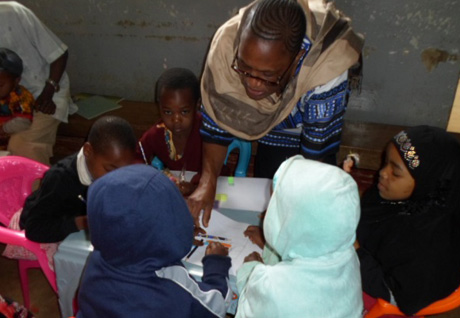IMA World Health/ Veronica Mkusa
High up the mountains, following a long winding road in the Tanga Region of Tanzania, there is a beautiful town called Lushoto. Surrounded by hills and trees, the town has beautiful scenery and cool weather throughout most of the year.
Lushoto, which has an HIV prevalence of 2.8%, has one government-owned district hospital – Lushoto District Hospital – along with 11 other health facilities providing HIV care and treatment clinic (CTC) services. The CTC at Lushoto District Hospital provides care and treatment to more than 3,800 people living with HIV/AIDS (PLHAs), of whom 465 are children who receive care at a special ‘Friendly Children HIV/AIDS Care and Treatment Clinic.’
Over the past two years, the scope, attendance and success of the clinic has grown due to the strong commitment and innovation of the CTC staff, as well as the support of the PEPFAR-funded LEAD Project and IMA World Health.
LEAD Project staff advised the CTC to conduct Children’s Clinic hours on Saturdays in order to reach children who attend school , which has facilitated attendance. Clinic staff have also received special training on care for children living with HIV and have become attuned the special needs and requests of children who attended the CTC. For instance, the staff observed that the children would often ask for a pen and paper while waiting for appointments, so they decided to provide flip charts, markers and ballpoint pens to keep the children stimulated and engaged. As the children wrote, the staff encouraged them, clapping and praising: ‘You have done well, keep it up!” … ‘You have tried hard!’ … ‘This is very good, thank you!’… ‘You are so creative, keep it up!’ This encouraged more children to engage in and find joy in the activity. Over time, the CTC staff’s love and spirit of care continued to grow, and they decided to buy exercise books and pencils using money from their own pockets.
The children soon realized that CTC staff were friends as well as doctors and nurses. This made the children more forthcoming with the CTC staff, and some started sharing additional needs, saying they were hungry and asking for food.
This triggered the CTC staff to consider providing food during Children’s Clinic hours. Funds to provide food were a challenge, so the clinic staff presented the idea to all Lushoto Hospital staff, who began to contribute money to buy flour; the CTC is now providing porridge on Children’s Clinic days. The Medical Officer In-Charge provides 10 liters of milk every month, while the District Nursing Officer contributes fruit and bread at every clinic.
A typical Saturday Children’s Clinic at Lushoto District Hospital now consists of children receiving medical care, being stimulated with writing and entertainment activities, and having their nutritional needs met. As a result, the Children’s Clinic has grown and has been running for the past two years with near perfect retention rates.
To make the child-friendly clinic sustainable, the proposed agenda activities were presented to the Council HIV and AIDS Coordinator (CHAC) and at the Council Management Committee (CMAC) so that this could be part and parcel of the Council budget. Therefore, through Council Community Development funds, the clinic was able to receive support to provide food to the children for three months, and through CHAC, supplemental funding for food for the clinic will be included in the Council’s main budget each year.
The leadership and support of CTC staff has inspired some local school teachers AIDS to provide porridge and food for the children at school, and many have gone to the extent of bringing the children who lack support at home to the clinic.
The children like the clinic and look forward to it so much that they remind their parents/guardians of Clinic days to make sure they don’t miss. The clinic is a special place for them; they are listened to, and they are cared for both clinically and socially.
IMA applauds Lushoto District Hospital for putting such care and attention into the Children’s Clinic, as well as Project LEAD for paving the way.
Project LEAD in Tanzania is implemented through a consortium of four non-Governmental organizations: Catholic Relief Services, (CRS), University of Maryland School of Medicine – Institute of Human Virology (IHV), Futures Group (FG) and IMA World Health.


